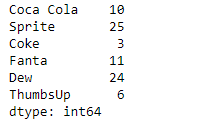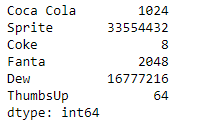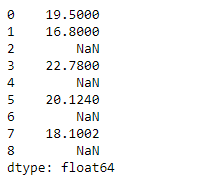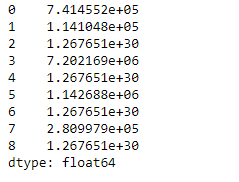Python Pandas Series.rpow()
Pandas系列是一个带有轴标签的一维ndarray。标签不需要是唯一的,但必须是一个可散列的类型。该对象支持基于整数和标签的索引,并提供了大量的方法来执行涉及索引的操作。
Pandas Series.rpow()函数返回系列和其他的指数幂,按元素排列(二进制运算符rsub)。它等同于其他系列,但支持用一个fill_value来替代其中一个输入中的缺失数据。
语法: Series.rpow(other, level=None, fill_value=None, axis=0)
参数:
其他:系列或标量值
fill_value :填补现有的缺失(NaN)值
level :跨层广播,与通过的MultiIndex层的索引值相匹配。
返回:Series
例子#1:使用Series.rpow()函数将一个标量值提高到给定Series对象中每个元素的幂。
# importing pandas as pd
import pandas as pd
# Creating the Series
sr = pd.Series([10, 25, 3, 11, 24, 6])
# Create the Index
index_ = ['Coca Cola', 'Sprite', 'Coke', 'Fanta', 'Dew', 'ThumbsUp']
# set the index
sr.index = index_
# Print the series
print(sr)
输出 :

现在我们将使用Series.rpow()函数将标量提高到给定系列对象中每个元素的幂。
# raise 2 to the power of each element in
# the sr object
selected_items = sr.rpow(other = 2)
# Print the returned Series object
print(selected_items)
输出 :

正如我们在输出中看到的,Series.rpow()函数成功地返回了一个系列对象,这是指数化操作的结果。
示例#2 :使用Series.rpow()函数将一个标量值提高到给定Series对象中每个元素的幂。
# importing pandas as pd
import pandas as pd
# Creating the Series
sr = pd.Series([19.5, 16.8, None, 22.78, None, 20.124, None, 18.1002, None])
# Print the series
print(sr)
输出 :

现在我们将使用Series.rpow()函数将标量提高到给定系列对象的每个元素的幂。我们将在所有缺失值的位置上替换为100。
# raise 2 to the power of each element in
# the sr object
selected_items = sr.rpow(other = 2, fill_value = 100)
# Print the returned Series object
print(selected_items)
输出 :

正如我们在输出中看到的,Series.rpow()函数成功地返回了一个系列对象,这是指数化操作的结果。
 极客教程
极客教程